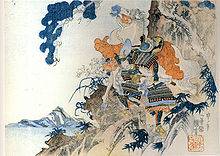Hatakeyama Shigetada
- Hatakeyama Shigetada
-

Statue d'
Hatakeyama Shigetada
Hatakeyama Shigetada (畠山重忠) (1164 - 1205) est un samouraï qui a combattu lors de la guerre de Genpei, au Japon. À l'origine luttant pour le clan de Taira, il a changé de camp pendant la Bataille de Dan-no-ura, pour finir la guerre du côté des vainqueurs.
Après la guerre, lorsque son fils Shigeyasu est tué par Tokimasa Hōjō, Shigetada s'insurge ; il est alors tué lui aussi, ainsi que toute sa famille. Sa tentative courageuse pour défendre son honneur, ainsi que diverses prouesses de force et d'habileté pendant la guerre lui ont gagné une place dans le Heike Monogatari et dans d'autres chroniques de la période, où il est félicité pour son courage et son habileté au combat.
Dans une anecdote amusante du Heike Monogatari, on dit de lui qu'il rivalise avec un certain nombre d'autres guerriers pour être le premier à traverser le fleuve Uji. Quand son cheval est tué d'une flèche dans la tête, il l'abandonne et utilise son arc pour nager. Juste au moment où il est sur le point d'atteindre la rive, son filleul Okushi no Shigechika lui demande de l'aide : il le saisit alors et projette sur la rive ; Shigechika se redresse alors et se proclame vainqueur, le premier à avoir traversé le fleuve.
Références
Wikimedia Foundation.
2010.
Contenu soumis à la licence CC-BY-SA. Source : Article Hatakeyama Shigetada de Wikipédia en français (auteurs)
Regardez d'autres dictionnaires:
Hatakeyama Shigetada — (畠山重忠) (1164 ndash; 1205) was a samurai who fought in the Genpei War, in Japan. Originally fighting for the Taira clan, he switched sides for the battle of Dan no ura, and ended the war on the winning side.Following the war, when his son was… … Wikipedia
Hatakeyama Shigeyasu's grave — nihongo|Hatakeyama Rokurō Shigeyasu|畠山六郎重保 was a Kamakura period warrior who fell victim of political intrigue in 1205. The grave under a tabu no ki tree near the Yuigahama end of Wakamiya Ōji Avenue in Kamakura, Kanagawa Prefecture, Japan and… … Wikipedia
Hatakeyama Shigeyasu — nihongo|Hatakeyama Rokurō Shigeyasu|畠山六郎重保 was a Kamakura period warrior who fell victim of political intrigue in 1205. The grave under a tabu no ki tree near the Yuigahama end of Wakamiya Ōji Avenue in Kamakura, Kanagawa Prefecture, Japan and… … Wikipedia
Hatakeyama clan — The nihongo|Hatakeyama clan|畠山氏|Hatakeyama shi was a Japanese samurai clan. Originally a branch of the Taira clan, and descended from Taira no Takamochi, after 1205 the Hatakeyama came to be descendants of the Ashikaga clan, who were in turn… … Wikipedia
Clan Hatakeyama — Le clan Hatakeyama (畠山氏) est un clan du Japon médiéval qui descend du clan Taira. Le clan fut un allié du shogunat Ashikaga contre la cour impériale du Sud lors de la période Nanboku cho. Le clan possédait à cette époque de nombreux territoires… … Wikipédia en Français
Hōjō Tokimasa — nihongo|Hōjō Tokimasa|北條 時政|extra=1138 1215 was the first Hōjō shikken (regent) of the Kamakura bakufu and head of the Hōjō clan. He was shikken from the death of Minamoto no Yoritomo in 1199 until his abdication in 1205. Background: The Hōjō… … Wikipedia
Yuigahama — Kamakura s Official Textbook for Culture and Tourism (2008:33)] . This is the reason why, although the beach gives its name to only the west part of the beachside community, traces of the name Yuigahama can be found also in Zaimokuza (for example … Wikipedia
Ōe no Hiromoto — The tomb of Ōe no Hiromoto in Kamakura In this Japanese name, the family name is Ōe . Ōe no Hiromoto (大江 広元) (1148–1225) was a kuge (court noble) and vassal of Japan s Kamakura shogunate, and contributed to establishing the shogunate s… … Wikipedia
Hōjō Yoshitoki — nihongo|Hōjō Yoshitoki|北条義時| (1163 1224) was the second Hōjō shikken (regent) of the Kamakura shogunate and head of the Hōjō clan. He was the eldest son of Hōjō Tokimasa and his wife Hōjō no Maki. He was shikken from the abdication of his father… … Wikipedia
Ōe no Hiromoto — Grab von Ōe no Hiromoto in Kamakura Ōe no Hiromoto (大江 広元; * 1148 (traditionell: Kyūan 4); † 16. Juli 1225 (traditionell: Karoku 1/6/10)) war ein japanischer Hofadliger (kuge) und trug als maßgeblicher Vasall des Kamaku … Deutsch Wikipedia


